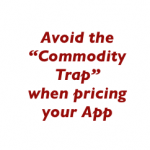SaaS vendors who know their customers know what they don’t value and avoid building a pricing strategy around those elements.

A client of mine – an established SaaS company in the HR space – wanted to pass on the storage costs associated with the use of the system to their end-customer.
I told them that their best bet was not to do that as it could put the focus of the customer on the wrong metric.
Instead of continuing to ensure their value proposition was aligned with the value perception of the customer, this move would put the focus of the customer on a commodity metric with little real value.
Here’s the deal… a quick search on Google shows you can buy a 500GB hard drive for $60, or about $0.12 per GB. Anyone can do that search and probably a lot of people have.
Even more, they probably weren’t happy when they did the search (few people buy a new hard drive because it’s fun).
Even if they haven’t actively sought pricing on a new hard drive, they know that a GB is super cheap these days.
So when you sit down to develop your pricing strategy for your SaaS or web service, and the pricing page to go along with it, you need to figure out if really makes sense to charge your customers an extra $20/month – or $240/year for an extra GB of storage space; something both you and they know they can get for $0.12.
Wait! “That argument doesn’t make sense” you say.
“We add value on top of the storage;” you manage that data for them, you do backups and have a disaster recovery plan, your data center is SAS70 certified… STOP… it doesn’t matter any more.
Whether you like it or not, your customer just did an apples to apples ROI comparison between two things that have absolutely nothing to do with each other; your complex web service and a commodity, desktop hard drive.
And it is all your fault. So now, the customer either won’t step-up to the next tier (holding back on usage or deleting objects) or they will because they have to but won’t be happy about especially since they “know” the huge profit margin you’re getting off of them.
More importantly is that even though they moved up, they might be actively looking for a way out.
You see, knowing that you add value is not enough; you need to tell the customer about the value you add and sell them on it.
Unless they’re buying a storage system (S3, online backups, etc.), at best focusing on “storage” is simply not aligned with the customer.
At worst, it takes their minds off of the true value you add and focuses it on some metric that they associate with a super-cheap commodity.
A great example of a company that did this well is Apple with the iPod.
When they decided to sell an digital audio player to compete with MP3 players on the market, they chose to sell a device with 5GB of storage.
But they didn’t promote it that way.
Instead, Steve Jobs knew that a storage metric – even in 2001 – did not have a lot of value with it.
If anything, it didn’t mean anything to the customer.
So, Jobs announced the 5GB iPod as a way to put “1,000 songs in your pocket.”
This means so much more to consumers and takes the focus off of the commodity metric and puts it where the value is derived.
So, how can you do that with your SaaS or Web App?
Not sure how to price your app, how to be more aligned with the customer’s value perception, and how to avoid the “Commodity Trap?” Check out my SaaS and Web App Pricing Resource Guide here.
Onward, upward, and to the right!
– Lincoln
(972) 200-9317


